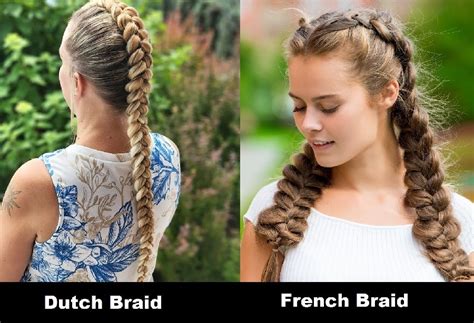Defining French and Dutch Braids
- French Braid: A three-strand braid originating from France, woven overhand (hair strands cross over each other from top to bottom).
- Dutch Braid: Also known as an “inverted” French braid, woven underhand (hair strands cross over each other from bottom to top).
Key Differences
| Feature | French Braid | Dutch Braid |
|---|---|---|
| Weaving Direction | Overhand (hair overlaps at the top) | Underhand (hair overlaps at the bottom) |
| Appearance | Flatter, more intricate appearance | Thicker, fuller appearance |
| Tension | Tighter, requires more tension | Looser, more relaxed appearance |
| Suitability | Thin or fine hair | Thick or coarse hair |
Advantages and Disadvantages
French Braids

- Advantages:
- More intricate and elegant appearance
- Ideal for thinner hair to add volume
- Can be adorned with hair accessories
- Disadvantages:
- More time-consuming to braid
- Can be difficult to master for beginners
Dutch Braids
- Advantages:
- Fuller, more voluminous appearance
- Easier to braid for beginners
- Adds texture and dimension to hair
- Disadvantages:
- Can look messy if not braided tightly enough
- May be too bulky for thin or fine hair
Applications
French Braids:
* Bridal hairstyles
* Formal occasions
* High fashion events
Dutch Braids:
* Casual hairstyles
* Sports activities
* Boho-chic looks
Tips and Tricks
French Braids:
* Maintain even tension throughout the braiding process.
* Use small sections of hair for a more intricate look.
* Experiment with different variations, such as half-up and side braids.
Dutch Braids:
* Loosen the braid slightly for a more relaxed appearance.
* Pull gently on the sides of the braid to create a wider effect.
* Add hair extensions for extra length and volume.
FAQ
1. Which braid is more difficult to master?
French braids require more precision and tension, making them slightly more difficult for beginners.
2. Are Dutch braids suitable for all hair types?
Yes, Dutch braids can be adjusted to suit most hair types. They look particularly flattering on thick or coarse hair.
3. Can I sleep in a French or Dutch braid?
Yes, sleeping in a braid can protect hair from tangles and breakage. However, it is recommended to braid hair loosely to avoid discomfort.
4. How often should I wash my hair before braiding?
It is best to wash hair 1-2 days before braiding to remove any oils or product buildup. This ensures the braid will hold better.
5. Can I braid hair that is wet or dry?
Hair that is slightly damp is easier to braid and allows for a tighter hold.
6. Are French and Dutch braids appropriate for men?
Yes, both French and Dutch braids can be stylish and flattering on men.
Conclusion
French and Dutch braids are both versatile and elegant hairstyles that can enhance any look. By understanding the key differences, advantages, and disadvantages of each braid, you can choose the best style for your hair type and occasion. Experiment with different variations, tips, and tricks to create the perfect braid for you.
